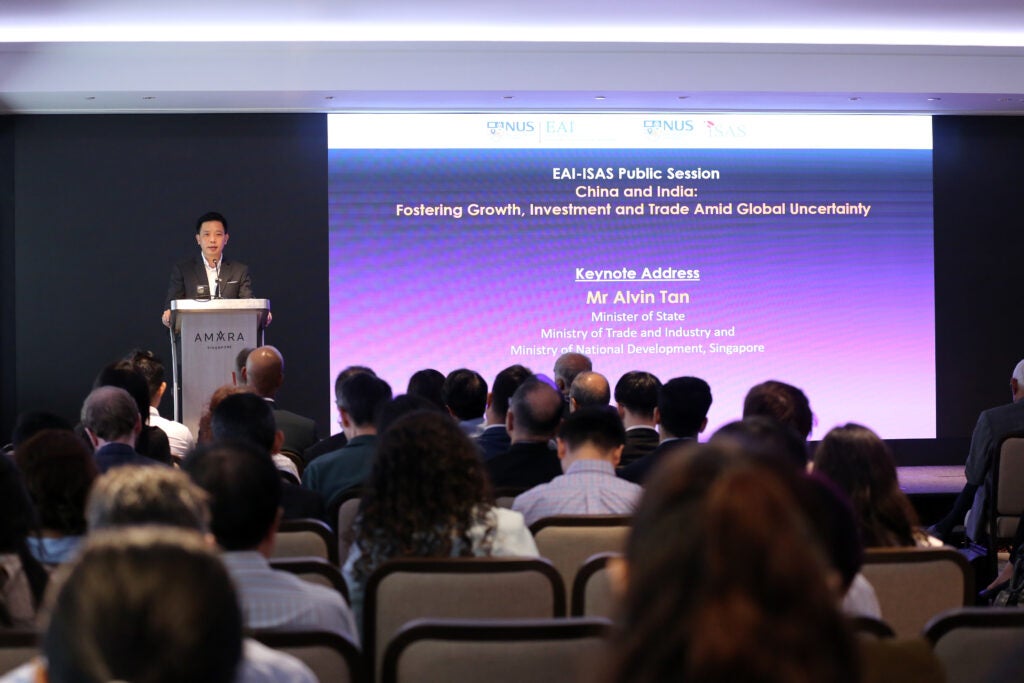EAI-ISAS Public Session: 8 September, 2025
The East Asian Institute (EAI) and the Institute of South Asian Studies (ISAS) at the National University of Singapore convened a public session on 8 September 2025 to examine how India, China, and Southeast Asia can sustain growth, strengthen investment flows, and reconfigure trade relations amid a fluid geopolitical landscape and rapid technological change. This session brought together policymakers, economists, and thought leaders to provide a comprehensive perspective on the opportunities and challenges that lie ahead for the region.
China and India: Fostering Growth, Investment
and Trade Amid Global Uncertainty
Overview
Amid a fluid geopolitical environment, rising uncertainty, and rapid technological change, China and India – Asia’s two largest economies – are helping shape the trajectory of global growth, investment and trade. This public session will examine how both countries are navigating today’s complex economic landscape, responding to shifting trade dynamics and advancing domestic reforms. It will also explore evolving trade, investment and financial flows, as well as the future of global economic governance and the role that Southeast Asia can play in this changing environment. The session aims to highlight shared challenges and opportunities and identify possible areas for collaboration.
Programme
| Time and Event | Speaker |
| 9.00am Registration / Tea Reception |
|
| 9.30am Welcome Remarks |
Professor Alfred Schipke Director, East Asian Institute |
| Introduction and Addresses | |
| 9:40am Introduction |
Mrs Rosa Daniel Dean, Culture Academy |
| 9:50am Keynote Address |
Mr Alvin Tan Minister of State |
| Stage Setting | |
| 10:00am |
Mr Vinod Rai Distinguished Visiting Research Fellow |
| 10:15am |
Dr Miao Yanliang Chief Strategist and Executive Head of Research Department |
| 10:30am Coffee Break |
|
| Panel Discussion | |
| 10:45am Moderator |
Associate Professor Iqbal Singh Sevea Director |
| 10:50am Presenters |
|
| 10:50am |
Mr Andrew Tilton Chief Asia-Pacific Economist |
| 11:00am |
Dr Amitendu Palit Senior Research Fellow and |
| 11:10am |
Dr Elitza Mileva Lead Economist (China, Mongolia and Korea) |
| 11:20am |
Mr Stephen Olson Senior Visiting Fellow |
| 11:30am |
Mr Manu Bhaskaran Founding Partner and Chief Executive Officer |
| 11:40am |
Mr Ignatius Lim Head, International/Government Relations Asia Pacific |
| 11:50am | Interactive Session |
| 12:30pm End |
Highlights from the Event

The Strategic Importance of China and India
The keynote address by Singapore’s Minister of State for Trade & Industry and National Development Alvin Tan stressed that the trajectories of China and India will profoundly influence global economic patterns. As two of the fastest-growing economies, they now account for roughly half of global growth and remain deeply embedded in global supply chains. Both countries are poised to excel in areas such as green technology, digitalisation, manufacturing, and services—though their relationship remains complex, characterised by both strategic rivalry and opportunities for dialogue.
ASEAN’s interest in stable relations between the two giants was also highlighted. Singapore, in particular, was portrayed as seeking to “go the distance” and to “go together” with both China and India, anchoring trust and long-term cooperation as it marks decades of diplomatic engagement with both partners.
India: Growth Momentum and Geopolitical Balancing
India’s economy was described as robust, with manufacturing, pharmaceuticals, and services driving impressive growth. However, concerns were raised about whether this momentum can be sustained given global uncertainty and tariff shocks. It was suggested that recent trade measures from the United States may have unintentionally pushed India closer to China, prompting policymakers to reconsider the balance between major power relationships.
The discussion stressed the need for India to adopt a nuanced approach—engaging China where beneficial, but avoiding over-reliance so as not to strain relations with other partners.
China: Navigating Disconnects and Structural Shifts
The Chinese economy was analysed through three “disconnects”: between top-down indicators and bottom-up firm performance, between domestic and foreign perceptions, and between government and private-sector sentiment. While macro data point to deflationary pressures and a slowing property market, company-level performance and global competitiveness remain strong.
Speakers highlighted the need for China to transition from property- and infrastructure-led growth to “new quality productive forces,” including innovation-led digitalisation and a green transition. Breakthroughs such as the development of AI platforms like DeepSeek were cited as evidence of the country’s technological dynamism, though these alone cannot offset structural headwinds in the short term.
Trade, Supply Chains, and Investment Flows
Global tariffs and supply-chain reconfiguration are reshaping trade flows. China’s exports are increasingly oriented towards emerging markets, while India is attracting greater inbound investment. India’s higher share of services exports and consumption-led growth model differentiates its adjustment path from China’s.
From an investor’s perspective, India is seen as a high-growth, high-yield but higher-risk market, whereas China remains attractive for its depth, infrastructure, and advanced supply chains. Investor interest in Chinese equities and technology firms remains strong despite global uncertainty.
Areas for Cooperation
Several panellists proposed practical avenues for Sino-Indian cooperation:
- Digital Finance: Interoperability of payment systems and exploration of central bank digital currency linkages could create significant efficiencies.
- Decarbonisation: Joint work on carbon pricing mechanisms and technology partnerships could accelerate both countries’ transitions to net zero.
- Regional Collaboration: Both economies could benefit from closer engagement with ASEAN, learning from its experience in carbon markets and leveraging its role as a production hub.
It was also noted that meaningful cooperation will depend on moving beyond summit symbolism and taking concrete steps in manufacturing joint ventures, technology transfer, and infrastructure partnerships—while managing geopolitical sensitivities.
Social Protection and Labour Markets
Speakers drew attention to the employment challenge, particularly in China, where GDP growth is no longer generating sufficient jobs, especially in services. Migrant workers and informal employees remain vulnerable due to limited social protection. Recommendations included expanding pension schemes, health coverage, and other safety nets to strengthen domestic demand and reduce economic insecurity.
In India, skill mismatches in the labour market were flagged as a priority area, with calls for more apprenticeship programmes, vocational training, and industry-aligned curricula to prepare workers for the demands of emerging sectors.
Southeast Asia’s Role
ASEAN was characterised as both a beneficiary and a participant in the reconfiguration of global trade. Its economies are better prepared than in the past, having strengthened fiscal positions, diversified exports, and improved financial supervision since the Asian Financial Crisis.
Supply-chain relocation was seen as a structural opportunity for the region, although the session cautioned that surges in Chinese exports risk triggering protectionist responses if not managed carefully. Smaller “coalitions of the willing” within ASEAN may take the lead in advancing integration and cooperation.
Conclusion
The public session concluded with a consensus that India and China must move beyond symbolic gestures and take practical, confidence-building steps to foster sustainable cooperation. Both economies face the twin challenge of sustaining growth while mitigating geopolitical and economic risks. By deepening social protection, embracing structural reform, and pursuing pragmatic engagement—especially in green technology, digital finance, and manufacturing collaboration—they can transform uncertainty into opportunity and anchor a more resilient Asian economic order.


